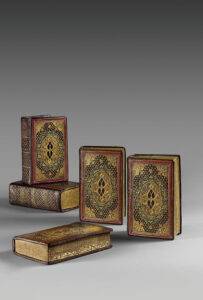Apud Seb. Gryphium, Lugduni [Lyon], 1556.
Eight parts bound in 5 volumes 16mo, roman characters, side notes. Ruled copy.
-Tomus primus: 748 pp. and 2 bl ll. Hieronymus Paulino. Liber genesis. Liber Exodus. Liber Leviticus. Liber Deuteronomii. Liber Josue. Liber Iudicum. Liber Ruth.
-Tomus secundus: 956 pp. and 2 bl. ll. Libri Regum. Paralipomenon. Esdrae. Tobiae. Judith. Esther. Job.
-Tomus tertius: 445 pp. and 1 bl. l. Psalmorum.
-Tomus quartus: 699 pp., 2 bl. ll, more than 160 pp. Prophetae. Machabaeorum.
-Tomus sextus: 332 pp. and 2 bl. ll., 96 pp. and 304 pp., without figures. Evangelistae quatuor. Acta apostolorum. Epistolae B. Pauli. Catholica. Apocalypsis.
Brown calf, large gilt decoration made of two listels on the covers, as well as corner pieces, and large central oval cartouche with scrolls, within its center two azure fleurons placed head to tails, the set enhanced with red, blue, black wax, flat spine decorated with treillis decoration on its panels, gilt and chiseled edges, tiny restorations to the joints. Contemporary binding from Lyon, towards 1556.
Dimensions of the bindings: 125 x 75 mm.
Extremely rare set of eight parts bound in 5 volumes of the Lyon bible by Sébastien Gryphe, without the part 5; Baudrier, the bibliographer of the printers from Lyon, provides a list of three French libraries that own one or the other part of this rare and remarkable bible, but nobody owns the complete set: the Bibliothèque de Lyon has the 1st part; the Bibliothèque Sainte Geneviève only the 1st part as well, only the Bibliothèque from the Mans has the 5 volumes.
“There are sometimes copies of this bible from Lyon covered with fine bindings with colored and richly decorated sections, as it use to be made in Lyon, and that collectors like to find, especially when they are well preserved, which is rare. It is one of this peculiar copies which was marked 550 fr. or in one of Mr. Tchener’s Bulletins, even though in an ordinary condition this books worth no more than 10 to 15 fr.”
(Brunet, I, 876; année 1867)
The impulse given by Grolier had spread throughout France and especially in Lyon, which was the most important center of book production, after Paris.
The bourgeoisie of this area was wealthy enough to wish, like the one in the capital, to own books magnificently bound in the line of current tastes of the time, or to order polychromatic bindings with decorations executed by press.
We can assume that the famous printer of this city, Sébastien Gryphe and Bernard Salomon, one of the best engravers of the Renaissance, actively contributed to the training and the development of this Renaissance art which also obtained the support of one of Grolier’s followers: the bibliophile from Lyon, Benoît Le Court.
“A large number of binding workshops were set up in Paris, since it was there that the king was living, his court and major of bibliophiles. Though, another town, regarding edition, binding and gilding, could compete with Paris: it was Lyon where printers such as Sébastien Gryphe or Jean de Tournes were practicing. Binders and gilders were very active. It seems that they specifically specialized in decorated polychromatic inlaid bindings. The master-piece of these craftsmen from Lyon was probably the binding covering Jacques Bassantin’s volume: Astronomique discours, ayant appartenu à Catherine de Médicis. »
(Yves Devaux.)
An exquisite and rare set preserved in its attractive gilt bindings from Lyon, chiseled and painted towards 1556, coming from the Thomas Brooke Armitage Bridge and Ex Museo hans Furstenberg’s collections with ex‑libris (one ex-libris from the 17th century bears a number of order for each of the five volumes: z 640, z 641, z 642, z 643 and z 644).
See less information

![Biblia Sacra Iuxta vulgatam editionem ad vetustissima exemplaria castigata. Pentateuchus moysi Iosve. Liber Iudicum ruth. [m. 2 bis]](https://www.camillesourget.com/wp-content/uploads/2023/03/biblia-sacra-reObG.jpg)
![Biblia Sacra Iuxta vulgatam editionem ad vetustissima exemplaria castigata. Pentateuchus moysi Iosve. Liber Iudicum ruth. [m. 2 bis] - Image 2](https://www.camillesourget.com/wp-content/uploads/2023/03/biblia-sacra-XMYW7.jpg)
![Biblia Sacra Iuxta vulgatam editionem ad vetustissima exemplaria castigata. Pentateuchus moysi Iosve. Liber Iudicum ruth. [m. 2 bis] - Image 3](https://www.camillesourget.com/wp-content/uploads/2023/03/005-c-biblia-sacra-mIYxy.jpg)
